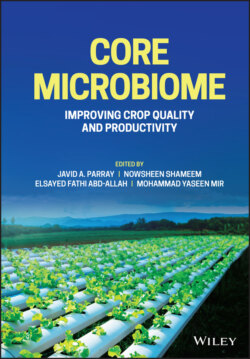Читать книгу Core Microbiome - Группа авторов - Страница 37
2.4.2.3 Antagonism
ОглавлениеMicroorganisms with antagonistic activity suppress the growth of phytopathogens and inhibits the subsequent development and activity of infectious agents. The richness of bacterial species and negative interactions positively promote the growth and development of the plant [100]. Moesziomyces albugensis carries potent antagonistic activity against the oomycete pathogen Albugo laibachii in the phyllosphere of wild A. thaliana [101]. Trichoderma strains with the antagonistic potential of secreting cell-wall hydrolyzing enzymes such as chitinases, proteases, and β-glucanases can degrade the cell wall of pathogens [102].
Pseudomonas strains directly inhibit wide variety of pathogens (i.e., P. syringae and B. cinerea) in the laboratory as well as infield [103,104]. Pseudomonas spp. produced phenazines, a group of heterocyclic secondary metabolites that antagonize phytopathogens [105]. The Pseudomonas spp. is also reported to produce many other potential biocontrol metabolites, i.e., siderophores, 4-hydroxy-2-alkylquinolines, cyclic lipopeptides, and rhamnolipids, which are a class of biosurfactants [106]. Xanthomonas oryzae pv. oryzae is responsible for bacterial blight, which is the most destructive and serious disease-affecting rice. Among bacteria, actinomycetes are gram-positive and produce 70% of the compounds with biological effects. A total of eight strains of actinomycetes are reported to have shown a positive effect on controlling Xanthomonas in vitro and reducing disease severity of bacterial leaf blight. STG-15 can control bacterial leaf blight incidence and is identified as Nonomuraea sp [107].
